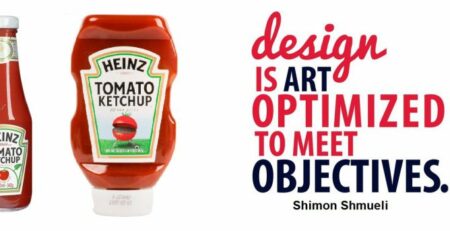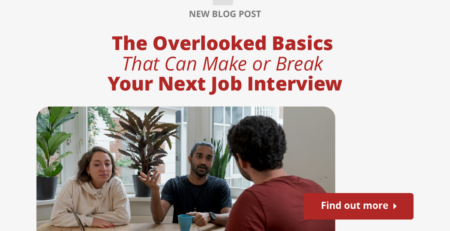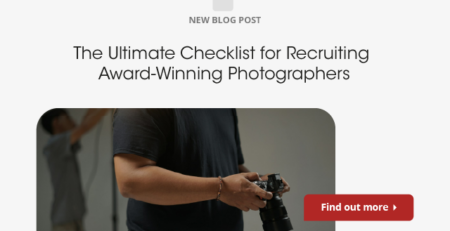Biggest Hiring Mistakes for Design Agencies in 2022
The hiring process is as complicated as it is important.
The wrong hire can set your company back—especially if it’s a small company. And even larger organizations will feel the effects of a bad hire. From headaches to financial costs, making a mistake in the hiring process can be a nearly permanent thorn in your side.
But as important as this process is, many hiring managers and organizations don’t put in the due diligence for watertight hiring practices. Things are either rushed, misunderstood, or mishandled in other ways. Not only is this bad for business, but it’s also bad for individual employees.
Knowing what’s what in the hiring process can set you miles ahead when trying to fill an open position. These are some of the biggest hiring mistakes to be wary of in your mission to fill open positions.
Not Taking Your Time
This is a theme that you’re going to see underlying many of the mistakes that agencies make when hiring.
When hiring, there’s a lot of emphasis placed on gut instincts and first impressions. This is a sort of romanticized notion that the ability and character of a person can be deduced quickly and without digging further than surface level. However, it’s also not the way you want to be hiring.
Chances are that you spend a lot of time at work, and you’re going to be dealing with this candidate a lot. Someone who gives off a great first impression can turn out to be a not-so-great fit. And on the flip side, someone else can give off a bad first impression due to nerves or other reasons, but they turn out to be a great fit.
Hiring someone means digging deeper to see who they’ll actually be on a day-to-day basis, not how they present themselves at the door. If you hire someone who either doesn’t fit the culture or their skills don’t match up to the work, all parties will be frustrated and you’ll soon be needing to hire again.
Not Seeing the Trees for the Forest
This follows from the previous point, but it’s worth expanding on. It’s important to focus on the minute details instead of the big picture when looking through potential candidates.
As a hiring manager or the owner of a creative agency, it becomes second nature to focus on the big picture—the forest. Without charting a path forward with regard to big picture aspects, leading and growing an organization becomes difficult. But while this is necessary for that part of running a business, you should be avoiding a “big picture” strategy when hiring.
Individuals don’t operate on a big picture perspective, at least not when carrying out their day-to-day tasks. That’s why it’s important to probe candidates on what makes them tick, their prior responsibilities, and their relationship with their previous employer and coworkers. This is the gritty stuff that’s actually going to matter when it comes to their job responsibilities and how they get along with the organization.
And if you don’t focus on these finer details, it could keep your big picture ideas from ever coalescing. It’s the individual details that will provide a solid foundation for long-term success.

Poor Onboarding
As great as a new hire can be, there still needs to be proper onboarding and training.
Bringing in someone new always requires a rundown of the way things are around your organization. From communication expectations to different processes, the things that make your organization need to be properly outlined.
Not only is a confused employee going to get a bad impression of the organization, but the productivity (and bottom line) of the company will also suffer as well. And again, it doesn’t really matter how much of a perfect fit someone is.
Each workplace has its own systems and idiosyncrasies, and the faster an employee can be caught up to speed, the better for everyone. Within the first 45 days of employment, many places have up to 20% staff turnover. This highlights the importance of proper onboarding procedures since the cost of turnover can be so high as well. Not to mention the fact that talent can slip through your fingers.
No Testing
Just like your employee will be getting a feel for the organization, you should be getting a feel for your new employee.
Even if you might’ve done your due diligence in the hiring process, it’s necessary to ensure that the new employee is actually performing as expected. If the organization goes several months before realizing that the employee’s skills just aren’t up to par, then it’s going to be very costly to then replace that employee. It’s better to know earlier rather than later.
This might not even come down to a lack of skills—the candidate might just not be the fit that you were looking for. Implementing reviews every few weeks in the first several months is a great way to ensure that there’s a good baseline for performance.
If an employee isn’t performing as they should, and you neither have the resources to train nor they the willingness to learn, then it’s best to let them go. That’s why it’s also important to maintain a stipulation around performance requirements for new employees.
You don’t want to go a year into having hired someone new just to realize that they don’t fit the needs of the organization.
Looking for a Quick Fix
On the other hand, it’s also important not to lean on new hires to fix specific problems.
If your firm is experiencing some kind of issue—either work hour related, efficiency related, or something else, it’s easy to go the path of least resistance. That means putting up a job posting looking for someone with the skills to fix your specific issue.
However, it doesn’t normally go like this, and again, it’s important to take one’s time with the hiring process. Finding a silver bullet for a larger issue in an individual employee might be the answer, but it’s important to be sure about this.
Creating a position or filling one with the wrong person is going to just cause frustration if things don’t seem to be working out as planned. Sometimes there are structural or procedural issues that an extra pair of hands on deck won’t be able to fix.
No Plan for Motivation
Even once you’ve done your due diligence in the hiring process, the work isn’t over yet. If you want to find good employees and retain them over the long term, it’s important to put in place a plan and a set of goals.
People have different motivations, but achieving goals is pretty much universal. There should be considerable time allocated for properly outlining achievable and well-defined performance indicators and a path for the future.
This will keep people aligned with the organization’s vision, and will also help to keep candidates motivated and invested in their work. This will in turn lead to lower turnover, and a happier business and workforce.
Not Asking for Feedback
It’s a good idea to implement some sort of feedback mechanism in the hiring process. And this doesn’t just need to come from those candidates that you’ve chosen, but also others who have gone through the process.
It’s easier than ever with technology and survey tools at your fingertips. Incorporating feedback will show you what works and what doesn’t, and will help you create a better hiring process that works for both you and your employees.
In fact, those that aren’t offered the position will likely have some of the best feedback—even if it might show that they’re unhappy. Facing these sorts of challenges head-on will help your hiring process and in turn, help your business grow.
No Clarity about Job Requirements
Not only should the job posting correctly reflect the characteristics of an ideal candidate, but you should also understand the role completely.
This still falls under the “taking your time” umbrella. It’s important to first come up with a clear picture of what the role actually will entail, and what’s necessary to succeed in it. It’s important to imagine the ideal candidate, which not only includes skills but also values and personality.
Once an idealized vision of the candidate is created, it’s time to put it into words. You can then use this to create a job posting that’s both succinct and informative. It’s a good idea to highlight the role that the candidate will fill in your position, while also highlighting the company culture. This will help people get a better idea of what the organization is all about, which will help to self-eliminate.
While succinctness is important, it’s equally important to show a clear outline of the position. This includes being transparent with things like the pay rate or the salary range. Being transparent will not only give a better impression of the agency but will also get everyone on the same page from the get-go.
Not Showcasing Company Culture
People want to know if they’ll be a good fit at work, and work culture is a big part of that. Most of us spend more time working than we do with our close ones, so this is an important factor to consider.
Having a good company culture is an obvious step one—candidates will be hesitant to associate with a firm that doesn’t have a great image, especially in a competitive industry. But it’s also important to display this positive culture when looking for candidates.
Benefits, flexibility, and different perks should all be showcased during the hiring process to draw in high-quality potential employees. This speaks to the workplace environment and is a major factor in considering where to apply and where to work. The more incentives and better company culture, the more talent you’ll be able to draw in and retain—both in the hiring process itself and further down along the road.
Hiring for Fit and Image
We did just talk about creating the “ideal” candidate, but you should also only be idealizing certain aspects of experience, skill, and the character that they bring to the table.
Don’t fall into the trap of hiring only people that complement a strict “fit” or “image” that you’ve created for the ideal employee. This can mean anything from looks, age, gender, personality, and any other characteristics of the candidate.
Not everyone needs to fill a very specific mold of how things should be and trying to find this ideal employee can result in missing out on some great candidates along the way. This is why it’s also important to distill the truly important aspects that make up an ideal candidate (because many are actually valid) and separate them from the “window dressing” that only highlights biases.
This also speaks to the importance of diversity when hiring. Hiring people with all sorts of experiences, from all walks of life, and particularly those that don’t fit into the “mold” is one of the best ways to bring new and fresh perspectives into your agency. Bringing in people who challenge this mold is important for the long-term health of a business.
Crunching Numbers (or not)
This problem is more specific to hiring salespeople at a creative agency, but it’s worth keeping in mind nonetheless.
Having a role specific to generating new business sounds like a great idea at face value—especially since this may not be the type of work we enjoy doing. That’s where salespeople come in, but it can be challenging to find one that bridges the gap between creative aspects and marketing.
Hiring the wrong salesperson can be especially costly, which is why it’s important to pay particular attention to this area.
One important part that many agencies go wrong with is the number crunching. On the one hand, this means that there’s enough of a profit margin left over while still giving your salesperson enough to incentivize them. But on the other hand, it’s necessary to know whether you’ll be able to handle the extra work brought in by the new employee. This could potentially result in having to hire more staff to keep up with the increased workload, which can affect overhead costs.
It’s important to ask yourself how many clients your agency can sustainably support, whether your margins will be large enough to factor in commission, and whether you’ll be able to give the salesperson enough accounts for them to meet their expectations.
Tips for Better Hiring
Now that we’ve looked at some of the biggest mistakes creative agencies can make when hiring, it’s easier to see what actually works.
Go slow and steady—with everything. There are no quick fixes to larger issues, and this is especially true when dealing with employees. It takes time to fully understand the position, its requirements, and the ideal candidate. It also takes time to craft a quality job posting that attracts the right people. Having a vision of what exactly you want will make things easier for everyone involved.
On the other hand, don’t be afraid of hiring candidates that don’t fit your image or the vibe you’re going for. It’s only shooting stars that break the mold, and breaking the mold will allow for a wider diversity of perspectives and a healthier work environment. This doesn’t mean you should ignore essential skills and experience, but it should allow some wiggle room in other respects. When interviewing, you want to know the details about an individual instead of basing things on a first impression, or the “big picture.”
Once you’ve brought on a candidate, the work doesn’t stop there. Onboarding and training take time and effort to give new employees a sense of the agency and its benefits and quirks. And as your new employee is getting a feel for the organization, you should be getting feel for them with testing and check-ins.

The Perfect Hire
The relationship that an organization has with its employees is in many ways, personal. And, just like all personal relationships, none of them are going to be sunshine and roses all the time.
Rather than hemming and hawing about finding the perfect employee in every respect, this is only going to set you back time and resources. Although we have been saying to take your time when hiring through this entire article, it’s just as important to set realistic expectations for yourself and others.
If a candidate ticks most of the boxes but is open to further training and is passionate about the work, they can prove more valuable than someone who already knows everything but has their own way of doing things. Having the tools to work with different employees with different needs is going to make both the hiring process easier and engage more people in work they find meaningful and important.
Hiring involves risk-taking, a lot of diligence, and plenty of time. But the right employee can shift the compass where it needs to go, and ultimately lead your agency to wider horizons.












